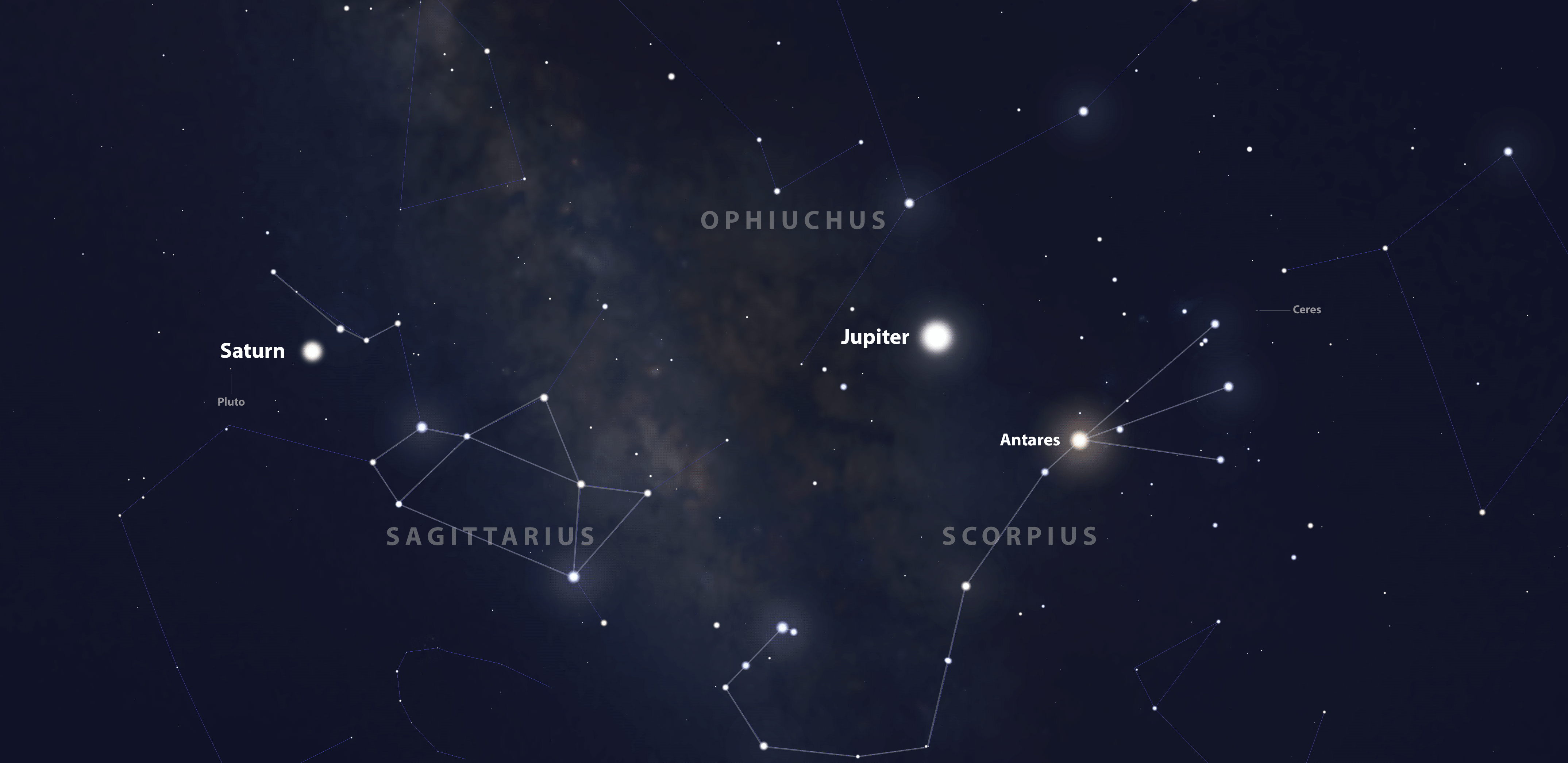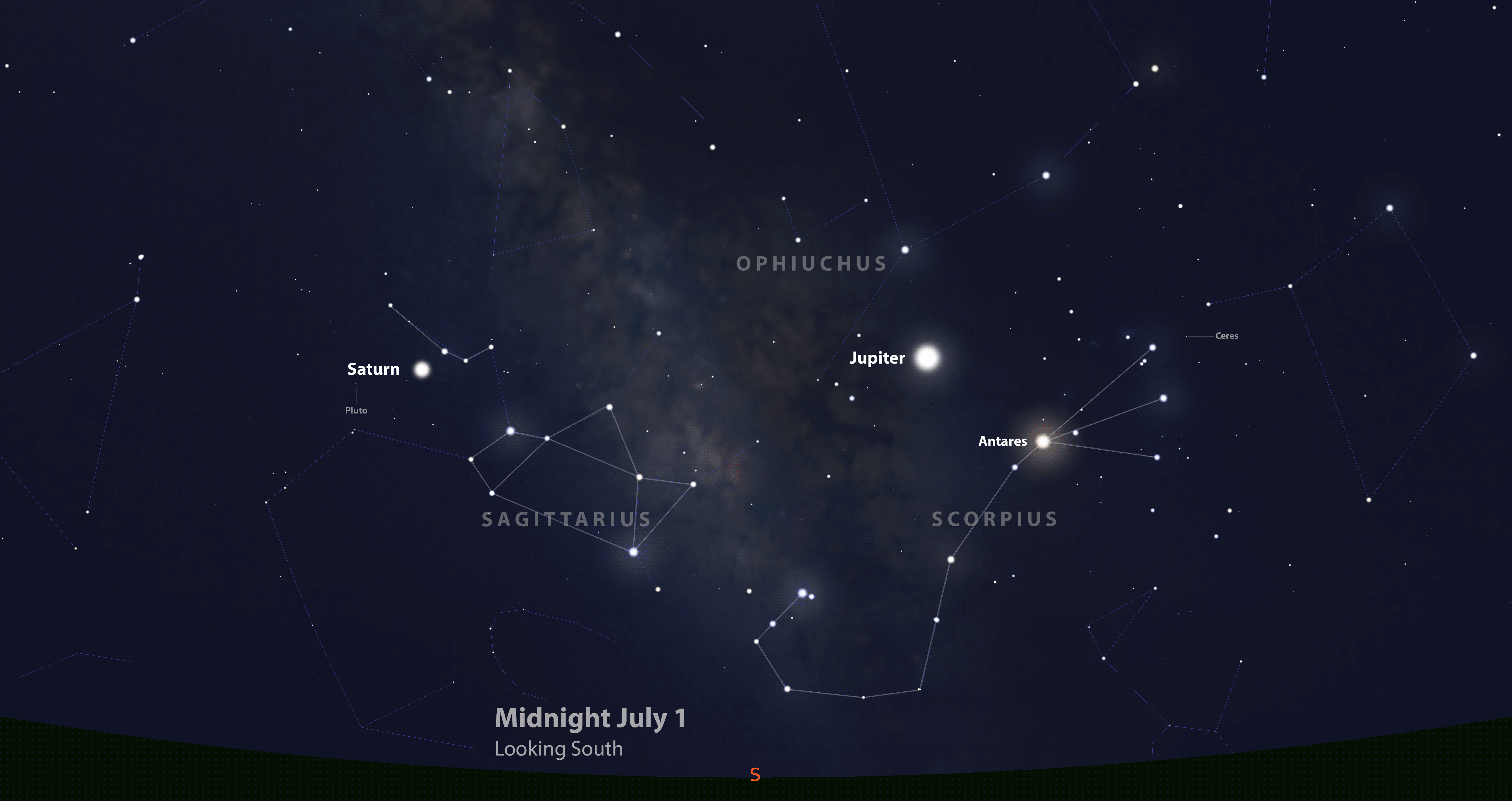
The Return of Jupiter and Saturn to the Evening Sky
July 2019 :
Note: This article may contain outdated information
This article was published in the July 2019 issue of The Skyscraper and likely contains some information that was pertinent only for that month. It is being provided here for historical reference only.
Quite a few months have passed since the local observatories have had the opportunity to provide detailed images of some of our planetary companions in the solar system. When weather conditions have allowed, the Moon has been a good substitute. When the Moon has not been available, telescope operators have turned to double stars and faint fuzzies like star clusters, galaxies and nebulae. However, these celestial objects don’t often elicit the wow factor that planetary viewing can do. Add some high thin haze, atmospheric turbulence, a little bit of moisture and light pollution, and it has been a challenge to provide decent views of the heavens. Our observing opportunities have now greatly improved.
While amateur astronomers have been observing Jupiter and Saturn during hours when most people are in REM dreamland, from now through November telescopes throughout Rhode Island will focus on exquisite views of these two gas giant worlds and all their glory. All I can say is, “It’s about time!!” This month’s column will provide a brief observing guide to Jupiter. Next month I will feature Saturn.
Back on June 10 Jupiter reached opposition. That means it rose as the Sun was setting. This date was also the date of Jupiter’s closest approach to the Earth for this year—about 397,850,855 miles. By July 1 this distance will have increased to 403,576,313 miles as the Earth pulls out ahead of Jupiter in our respective orbits. Fortunately, views of the Jovian system do not suffer dramatically from rapidly increasing distance.
However, Jupiter currently traverses a shallow arc across the sky because it, and all the planets, follows the ecliptic (path of the Sun and the plane of the solar system). Unfortunately because the ecliptic is low in our summer night sky, this scenario will keep Jupiter within some of summer’s often murky atmospheric conditions no more than 26 degrees above the southern horizon. Regardless, Jupiter reveals much detail even with small amateur telescopes.

First, you need to locate Jupiter among the constellations. Currently Jupiter resides among the stars of a not so obvious pattern of stars called Ophiuchus. Lucky for us a more recognizable Scorpius is a neighboring star pattern. (See the accompanying star map.) Bright Jupiter will be to the east (left) of Scorpius’ brightest star, red Antares. Focus in on Jupiter with your own telescope and begin your exploration, or let the volunteers at the local observatories guide your viewing pleasure.
It’s hard to predict what you will notice first. Will it be Jupiter’s large striped disk, or will it be some of his moons that grab your attention?
Let’s begin our examination with the planet itself. Jupiter is quite large; you could fit 1,321 Earths within its volume. Despite its distance from the Earth, this giant world is exciting to observe through any sized telescope. The striped appearance of the primary dark bands and lighter zones are easy to see, though the famous centuries old Great Red Spot (GRS) is no longer very great Over the last 150 years or so detailed measurements have revealed that the GRS has shrunk by 50%, and in more recent years its oval shape has become more circular.
In fact, some astronomers have speculated that this long-lived storm may be dissipating. Recent observations have revealed that the GRS exhibits indications that it may be “unraveling.” We may be witnessing an historical event in the near future if this degeneration continues. Review this link for details about the recent GRS event:
While the color of the GRS has changed throughout the decades, its lighter salmon coloring has made it a little more difficult to detect during the last decade. However, according to a recent Sky and Telescope article, “Over the last few years, the GRS has been sporting a rich, orange-red color…” This color enhancement makes the GRS much easier to detect if it is facing the Earth. Transit times of the GRS are available at this web site: http://www.skyandtelescope.com/observing/interactive-sky-watching-tools/transit-times-of-jupiters-great-red-spot/. Keep in mind that Jupiter rotates once in ten hours, so each night you will see different views of the planetary disk.
Or exploration of Jupiter will now focus on his four prominent satellites, called the Galilean moons in honor of their discoverer Galileo Galilei on January 7, 1610. These moons, given names from Greek mythology, are Io, Europa, Ganymede and Callisto. They are easily observed in small telescopes as they orbit around Jupiter. When several of the moons are visible at the same time, they often appear in a straight line, parading around Jupiter in the plane of its equator. This arrangement presents many interesting phenomena for us earth-bound astronomers to observe.
When a moon passes in front of Jupiter and casts a shadow onto the Jovian cloud tops, it is called a shadow transit. Besides seeing the satellite’s shadow, you may also see the bright disk of the satellite traversing Jupiter’s clouds at the same time, though this event is more difficult to observe. A moon may also pass behind the planet, which is called an occultation. Jupiter’s shadow can even eclipse a satellite as well; gradually the moon will either blink out or reappear. Also, it’s fun to watch all four moons line up on one side of the planet. I love to watch Jupiter over an extended period of time during the course of one evening because the view is dynamically changing as you watch.
In conclusion, if you just can’t wait for my Saturn observing guide next month, this beautiful ringed world comes to opposition on July 9 in the constellation of Sagittarius. Since Saturn also tracks across the sky on the ecliptic it will take some time to rise high enough above horizon haze to observe. If you wait until July 15 at 11:00 p.m. you will find Saturn to the left of Sagittarius’ “teapot handle” asterism. About one degree to the right will be a waxing gibbous Moon, just one day from Full. More details next month.
Over the next five months I encourage you to drag those telescopes you may own out of the attic or up from the basement and have them collect the light of Jupiter instead of dust! If you don’t have a telescope, or you wish to observe greater detail than what it could provide, please visit one of the local observatories for incredible views of Jupiter, Saturn and other astronomical objects. Seagrave Memorial Observatory (http://www.theskyscrapers.org) in North Scituate is open every clear Saturday night. Ladd Observatory (http://www.brown.edu/Departments/Physics/Ladd/) in Providence is open every Tuesday night. The Margaret M. Jacoby Observatory at the CCRI Knight Campus in Warwick (http://www.ccri.edu/physics/observatory.htm) is open every clear Thursday night. Frosty Drew Observatory (http://www.frostydrew.org/) in Charlestown is open every clear Friday night. Be sure to check the respective websites for any schedule update before venturing out for a visit.



